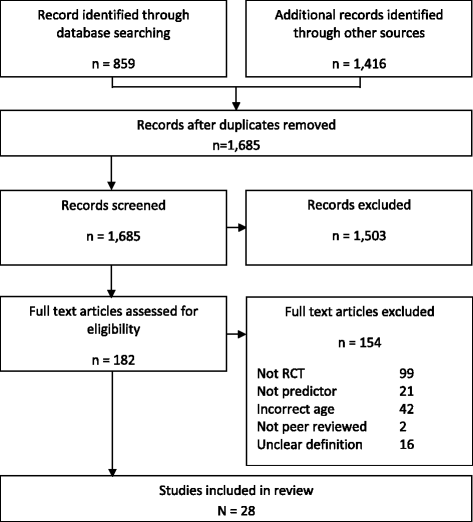Identifying the participant characteristics that predict recruitment and retention of participants to randomised controlled trials involving children: a systematic review
- PMID: 27334018
- PMCID: PMC4918126
- DOI: 10.1186/s13063-016-1415-0
Identifying the participant characteristics that predict recruitment and retention of participants to randomised controlled trials involving children: a systematic review
Abstract
Background: Randomised controlled trials (RCTs) are recommended as the 'gold standard' in evaluating health care interventions. The conduct of RCTs is often impacted by difficulties surrounding recruitment and retention of participants in both adult and child populations. Factors influencing recruitment and retention of children to RCTs can be more complex than in adults. There is little synthesised evidence of what influences participation in research involving parents and children.
Aim: To identify predictors of recruitment and retention in RCTs involving children.
Methods: A systematic review of RCTs was conducted to synthesise the available evidence. An electronic search strategy was applied to four databases and restricted to English language publications. Quantitative studies reporting participant predictors of recruitment and retention in RCTs involving children aged 0-12 were identified. Data was extracted and synthesised narratively. Quality assessment of articles was conducted using a structured tool developed from two existing quality evaluation checklists.
Results: Twenty-eight studies were included in the review. Of the 154 participant factors reported, 66 were found to be significant predictors of recruitment and retention in at least one study. These were classified as parent, child, family and neighbourhood characteristics. Parent characteristics (e.g. ethnicity, age, education, socioeconomic status (SES)) were the most commonly reported predictors of participation for both recruitment and retention. Being young, less educated, of an ethnic minority and having low SES appear to be barriers to participation in RCTs although there was little agreement between studies. When analysed according to setting and severity of the child's illness there appeared to be little variation between groups. The quality of the studies varied. Articles adhered well to reporting guidelines around provision of a scientific rationale for the study and background information as well as displaying good internal consistency of results. However, few studies discussed the external validity of the results or provided recommendations for future research.
Conclusion: Parent characteristics may predict participation of children and their families to RCTs; however, there was a lack of consensus. Whilst sociodemographic variables may be useful in identifying which groups are least likely to participate they do not provide insight into the processes and barriers to participation for children and families. Further studies that explore variables that can be influenced are warranted. Reporting of studies in this field need greater clarity as well as agreed definitions of what is meant by retention.
Keywords: Randomised controlled trial; Recruitment; Retention.
Figures
References
Publication types
MeSH terms
LinkOut - more resources
Full Text Sources
Other Literature Sources
Medical


